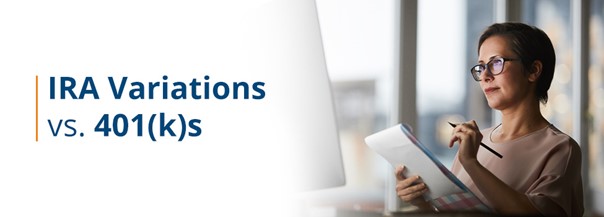IRAs vs. 401(k)s

There are many options when it comes to saving for retirement. Your employer might have mentioned setting up a 401(k). You might have heard a friend or relative talking about their individual retirement accounts (IRAs). How can you know which retirement plan is right for you?
There are many factors to consider when determining which retirement plan best suits you. Let’s look at the differences and similarities between 401(k) plans and IRAs.
What Is an IRA?
An individual retirement account is a tax-advantaged way to help you save money for retirement. However, there are a few different types of IRAs. Let’s take a look.
- Traditional IRA: Is an individual retirement account (IRA) with taxes deferred on any potential investment growth. Contributions can be made with pre-tax or after-tax dollars. With most Traditional IRAs, you are deferring the income tax on contributions today to a later date, usually in retirement.
- Roth IRA: This IRA account offers tax-free growth. You only pay taxes when you make unqualified withdrawals before retirement. Once an individual reaches 59 1/2, that is usually not an issue. Unlike traditional IRAs, you make Roth IRA contributions with after-tax dollars.
- Simplified Employee Pension (SEP) IRA: This account allows employers to contribute to traditional IRAs established for employees. Businesses of all sizes can set up SEP IRA accounts.
- Savings Incentive Match Plan for Employees (SIMPLE) IRA: This account allows employees and employers to contribute to traditional IRAs established for employees. The difference between SEP and SIMPLE IRAs is that employees can contribute to SIMPLE IRAs.
What Is a 401(k)?
A 401(k) is a retirement plan offered by an employer. If the company you work for offers a 401(k) plan, you can choose to have a certain amount of money deducted from your paycheck each period and deposited into your 401(k) account.
Contributions to a 401(k) can be pre-tax, meaning you don’t pay income or other taxes on them now. Instead, you pay tax on the withdrawal from pre-tax contributions during retirement. Contributions to a 401(k) can also be Roth contributions which does not reduce taxable income today, but could provide non-taxable income in retirement. Depending on your income now and your income in retirement, contributing to a 401(k) plan can help to lower your overall tax bill.
What sets a 401(k) apart from other investment and savings options is that you can only access one if your employer sponsors a plan. If you are self-employed or don’t have a full-time job, you likely won’t have access to a 401(k). Some companies do not offer 401(k) plans, even for full-time workers.
If you work for a government agency you are most likely taking advantage of a 457 plan. If you work for a nonprofit, there is a good chance you are taking advantage of a 403(b) instead of a 401(k). These retirement savings accounts are very similar to 401(k)s, except they’re available for public agencies and nonprofits and are exempt from some administrative costs that apply to 401(k) plans.
How IRAs Compare to 401(k)s
The various IRA types have similarities and differences to 401(k)s.
1. Traditional IRA vs. 401(k)
When it comes to taxes, traditional IRAs and 401(k)s are a lot alike. You defer paying taxes on the money you contribute into the account. The funds grow within an investment vehicle tax deferred. As you start to withdraw in retirement, you will pay taxes only on the amounts withdrawn each year.
However, a traditional IRA’s contributions limits are typically lower than a 401(k)’s contributions limits. Also, unlike 401(k) accounts, which are employer-sponsored, you must personally open the IRA with an appropriate institution like a bank and/or investment firm.
You must have earned income in a particular tax year before you can contribute to a traditional IRA and there is no age limit. However, distributions must start by age 73. The IRS requires that you take your Required Minimum Distribution (RMD) each year. You could take more but never less than this amount. The total amount of RMDs can be combined and taken from any one pre-tax retirement account.
2. Roth IRA vs. 401(k)
Contributions to a Roth account are made with after-tax income. This means you pay taxes on the money you put in today and this will allow you to withdraw during retirement without incurring further taxes.
Roth IRAs have income eligibility limits for contributions, which is not the case for Roth 401(k)s. Employees can contribute to their Roth 401(k) accounts and potentially gain employer matching dollars in addition to their personal contributions.
3. SEP IRA vs. 401(k)
Simplified Employee Pension IRAs are an option for businesses of any size, as well as self-employed individuals. The employer makes the contributions. Generally, employees cannot contribute. Conversely, 401(k) plans can also be opened for businesses of any size but allow contributions from the employer and/or employees.
SEP IRA contribution limits are higher than traditional pre-tax IRAs, Roth IRAs and 401(k)s. The SEP IRA contribution limit for 2024 is $69,000, the traditional and Roth IRA contribution limit for 2024 is $7,000 (under age 50), the 401(k) contribution limit for 2024 is $23,000 (under age 50), the SIMPLE IRA contribution limit for 2024 is $16,000 (under age 50). There are additional catch-up contribution limits in addition to these for most plans to allow older citizens to save more toward retirement.
4. SIMPLE IRA vs. 401(k)
SIMPLE IRAs are employer-sponsored retirement plans for businesses with 100 or fewer employees. Similar to 401(k)s, employers can match employee contributions up to 3%, but contribution limits are typically lower than those of 401(k)s.
SIMPLE IRAs also have simpler administrative requirements than 401(k) plans, making them easier for small businesses. There are lower administrative costs, no discrimination testing, and fewer intensive reporting requirements.

Another general difference between IRAs and 401(k)s is that IRAs allow you to choose from various options, including savings and investment choices. 401(k)s are limited to what your employer offers in the plan.
Contributing to a 401(k)
You contribute a percentage of your gross salary to a 401(k). However, there are limits to the total amount you can contribute annually. The contribution limit for 2024 is $23,000. People over the age of 50 can contribute an extra $7,500 per year to their 401(k) plans to help them catch up on retirement savings.
Since your employer administers 401(k) plans, they are responsible for withholding the money from your paycheck and depositing it into your account. If you want to change how much you contribute to your plan each pay period, you need to contact the department at your employer that handles employee benefits.
401(k) and Employer Match
Although you are limited in your annual contributions, there is a way to increase the amount in your 401(k). Some employers offer to match contributions to a plan, usually up to a certain percentage of an employee’s salary. The amount of the match varies based on the company. An employer may match every dollar you contribute up to 3% of your salary. Others may offer a match of 50 cents for every dollar contributed, up to 6% of your salary.
The employer match is optional, so each company decides its match rules. Occasionally, a company won’t match contributions at all. Others may offer a match, but only to employees working there for a specified period.
Contributing to an IRA
Like a 401(k), you can contribute as much as you want to an IRA during the year up to the lesser of 100% of earned income or maximum contribution limits. For 2024, the contribution limit is $7,000 per year. People over the age of 50 can contribute an additional $1,000. The annual contribution limit is per person. If you open a traditional and Roth IRA, the savings apply to the combined accounts, not individual.
Since you are responsible for opening and contributing to an IRA, you can decide when and how much to deposit into your account. You can set up monthly deposits or contribute every quarter. You can also make the full contribution to your account at any time during the calendar year and up to when you file your taxes the following spring.
Accessing the Money in a 401(k) Plan
The money you contribute to a 401(k) plan is meant to be there for you in retirement. That means there are penalties if you withdraw funds early, usually before age 59 ½. If you take money out of your 401(k) before retirement age, you’ll need to pay income tax on the amount you withdraw, plus a 10% penalty tax assessed by the IRS.
Some 401(k) plans allow for hardship withdrawals before retirement age. You might not pay a penalty on hardship withdrawals, but you might pay income tax. To qualify for this type of withdrawal, your employer must recognize that you have an immediate and heavy financial need and allow for hardship withdrawals in their plan.
You might also be able to borrow from your 401(k), usually up to the lesser of 50% of the account balance or $50,000. You pay the loan back to the account via payroll deduction, with interest, over time.
Since IRS penalties are eliminated at 59 ½, usually when you retire, you can withdraw your retirement savings without incurring penalties. The income is taxable unless you use a tax-free alternative like a Roth 401(k) or IRA and make qualifying distributions. Once you reach age 73, you must withdraw the Required Minimum Distribution (RMD) level each year from pretax retirement savings.
Accessing the Money in an IRA
The money you contribute to an IRA is meant to be used in retirement. There are penalties if you make unqualified withdrawals from an IRA before the age of 59 ½. A Roth IRA must be open 5 years and the owner must be 59 ½ to have a qualified withdrawal.
There are exceptions to the rule. Since you’ve paid tax on contributions to a Roth IRA, you don’t have to pay income tax or the penalty tax when you withdraw your contributions as a qualified distribution. You can also avoid the penalty if you withdraw from an IRA to pay for education, your first home, or certain medical expenses.
Much like 401(k)s, once you reach the age requirement to withdraw, you can begin using your IRA without any tax penalty, but this will be treated as taxable income unless you have a Roth IRA. Once you reach age 73, you must withdraw at least the RMD from your traditional IRA like you would with a pre-tax 401(k).
What Happens to a 401(k) Plan When You Leave a Job?
Leaving a job means you won’t be able to contribute to that 401(k) anymore, but that doesn’t mean you will lose access to the money you saved. You have a few options when you change jobs.
If you have more than $7,000, you can leave the money in the 401(k) with a former employer. You can leave the money alone, letting your investments and savings grow over time. If you choose this option, you might have to pay the administration fees that your employer was paying.
You can also transfer the money in your old 401(k) into the plan offered by your new employer if the new employer offers a retirement plan. If you have less than $7,000, your former employer can force you to transfer the funds into an IRA.
Can You Contribute to a 401(k) and an IRA?
After looking at the differences between a 401(k) and an IRA, you might conclude that both look like good choices, and you’re not sure how you will narrow it down. The good news is you don’t have to choose between one or the other. If you are eligible for a 401(k) plan through your employer, that doesn’t necessarily mean that you can’t also open and contribute to an IRA. But keep in mind there are some income limits to consider when it comes to the IRA funds being tax deductible.
Making the Ideal Choice
If you want to save as much as possible for retirement, it makes sense to contribute to a 401(k) offered through your employer and to an IRA. If you can make the maximum contributions to both accounts, you are setting yourself up for the best results when saving for the future. However, not everyone can save the maximum aggregate contribution amount per year for retirement. In those cases, you’ll want to look closely at your options before deciding where to put your money.
Since you can have a 401(k) and an IRA, which makes more sense to open and contribute to first? If your employer offers a 401(k) and will match your contributions, it’s usually a good idea to contribute what you can to that account up to the matching limit. Getting the employer match on a 401(k) is like earning bonus money. If they are offering it, it’s usually in your best interest to take it.
If your employer has a 401(k) but doesn’t match contributions, it’s often best to focus on contributing to an IRA first. You usually have more investment options and flexibility for making contributions with an IRA than a 401(k).
Whether you contribute to a traditional or Roth IRA depends on your income and what you expect your tax bill to be like in retirement compared to today. You also need to take into account how many years of potential compounding growth the retirement account could have. Younger retirement savers may find that a significant amount of growth can accumulate over 30 or 40 years toward retirement and the taxation of those gains, or lack thereof with a Roth, should also be considered. Compounding growth makes contributing earlier a wise decision as those gains accumulate and can have a sizeable impact later in life.
Contributing to a 401(k) or an IRA is a smart way to prepare for the future. Retirement might seem like years or even decades away, but the sooner you start planning for it, the better prepared you’ll be when it does arrive.
Contact our Wealth Management Team
Our Wealth Management team at Mid Penn Bank offers investment consulting services to our clients.
Our investment professionals would be thrilled to have the opportunity to talk through retirement planning options and solutions to help you save toward your retirement goals. Contact us today to learn more about our services and your retirement planning options.
Phone: 855-364-3847
Email: Julie.bramlitt@osaicinstitutions.com

Share:
Disclosures
The material on this site was created for educational purposes. It is not intended to be and should not be treated as legal, tax, investment, accounting, or other professional advice.
Securities and Insurance Products:
NOT A DEPOSIT | NOT FDIC INSURED | NOT BANK GUARANTEED | NOT INSURED BY ANY FEDERAL GOVERNMENT AGENCY | MAY LOSE VALUE
